
It is always stimulating to hear a recital by a real thinking musician and it was just this that Cranleigh Arts offered to us in a performance live and streamed.In partnership with the Keyboard Trust Damir Duramovic not only offered a fascinating programme but also spoke with such refreshing simplicity and intelligence about his musical pedigree.
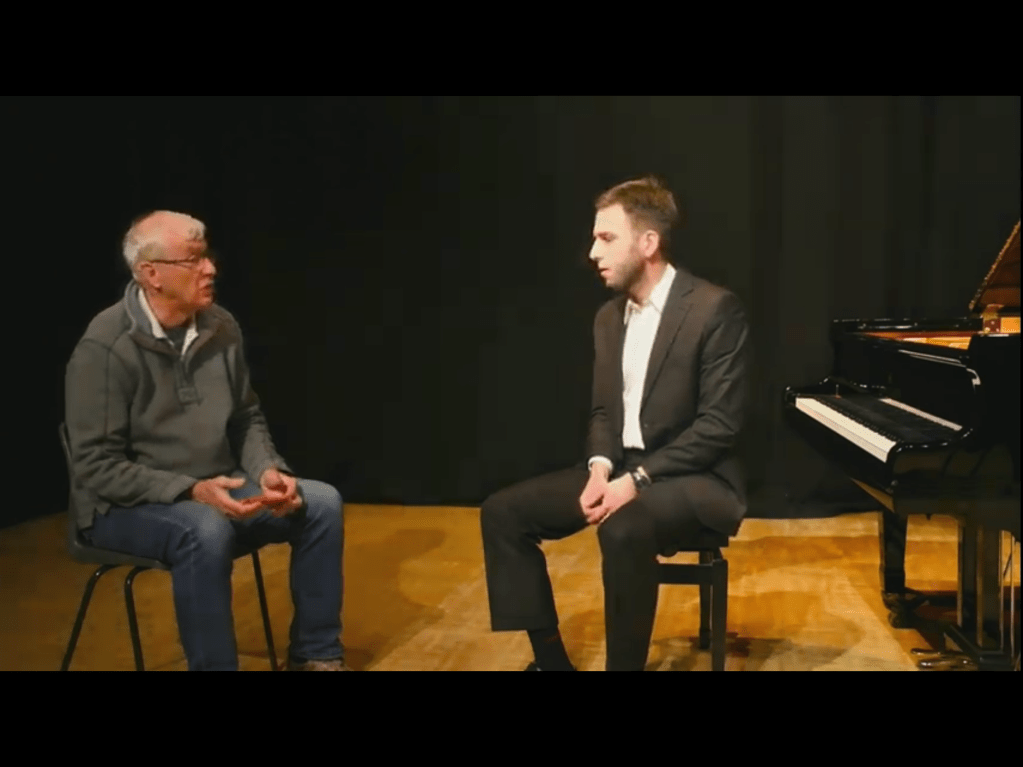
An informal conversation with Stephen Dennison during the interval for those like me watching from afar.No gin and tonic but another type of tonic to hear this young artist describe the unparalleled education that he had received from the age of fourteen at the Menuhin School.As it happens Cobham is just a short drive away from Cranleigh.An illustrious list of musicians who he had been able to come into contact with in his formative years .But it is Robert Levin who stands out for the obvious influence that he had on a young student fresh from Bosnia.A country as he explained where folk music and improvised performances were more the norm than classical concerts.Of course he received the state musical education from the schools run on the Eastern European system of serious training from an early age.Damir was lucky as a teenager to continue this early training with Marcel Baudet at the Menuhin and Dmitri Alexeev at the Royal College,both superb trainers of so many magnificent musicians.But there is a moment in one’s youth when a light is suddenly illuminated and it is this influence that remains into maturity.Both Can Arisoy and Damir spent their schooldays together at the Menuhin School in Cobham and they are both two of the most complete musicians that I know amongst the younger generation.Both obviously greatly inspired by the authority and scholarship of Robert Levin and the teaching of Marcel Baudet.
In their fascinating conversation Damir described how he organised a recital programme around key relationships and that he even improvised between each piece where necessary to prepare the ear by moving to the dominant key of the work that was to follow.The ‘historic’ performance practices of ornamentation and rhythmic adjustments were all elements that Damir explained were to bring the works he played back to life with the same sense of voyage of discovery as when the ink was still fresh in the page .He explained that this and choosing from different styles was his way of getting away from the standardised ‘recital’ formula and breathing new life into interpretations not only of recognised master pieces but also compositions long forgotten and now completely overlooked.
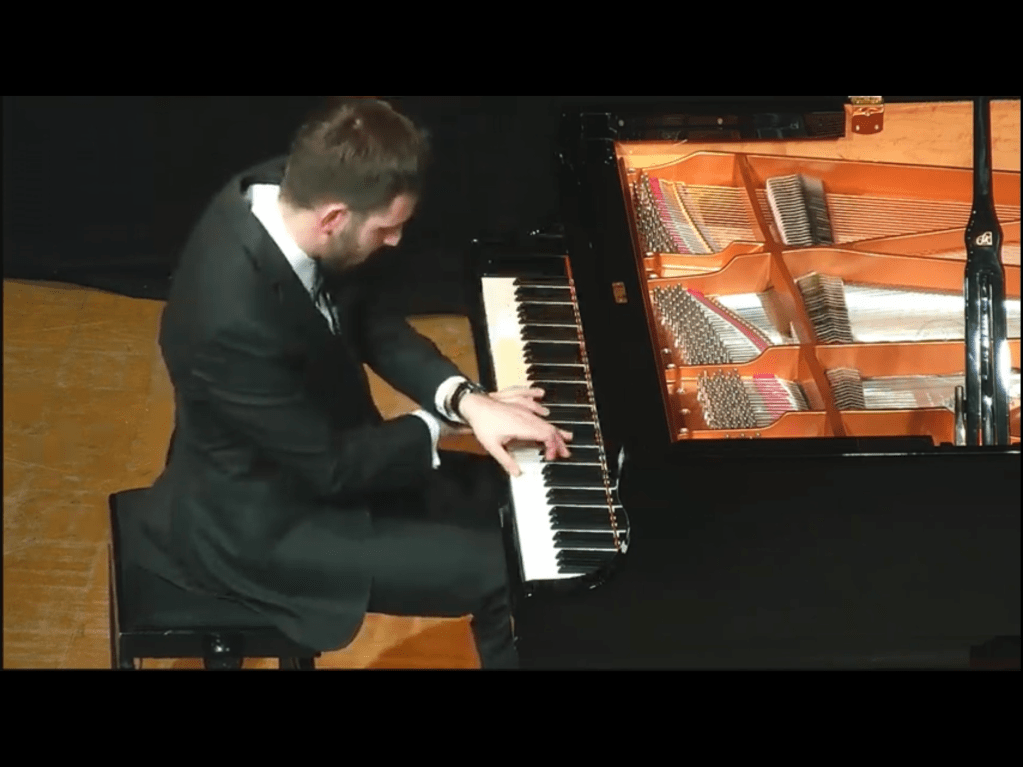
And so it was that the programme in Cranleigh was carefully thought out and spanned from Bach to Strauss with an unknown Lachner thrown in as a bridge between Chopin’s masterpiece op 61 and much lighter salon pieces.Ending with a Tausig arrangement of Strauss that one might well have encountered in recitals of the Golden age of piano playing at the beginning of the twentieth century in the hands of the legendary Lhevine ,Godowsky or Rachmaninov .Damir’s musicianship shone through all that he did as he created a sound world which was so flexible one felt that it could unfold in so many unexpected ways.A natural timelessness where even slight blemishes were incorporated into the music making of the moment.There was also great passion and driving energy but it was the music making of a kapellmeister that was very similar to that of Wilhelm Kempff.Such was Kempff’s total absorption in music he would arrive at a recording studio asking what they would like to record that day.He,more than any other pianists I have heard had the same preparation as the real musicians that would have to prepare music every week for the church and more often than not have to improvise much of the music as well as preparing the choir.A complete musician where music would pour out of them as naturally as breathing .

Damir’s Bach was of a crystal clarity where the single parts were played with a simplicity and purity with the ornaments adding the emotional expression that together with slight rhythmic deviations was the practice in Bach’s day.There was grandeur in the Fantasia but never clouding the texture or the clarity of the architectural line.
The first of four duets published in 1739 as part 3 of the Clavier Ubung consists of a double fugue of 73 bars in which the material is invertible: for example, it is possible to invert the two parts. The first subject is exhibited in six bars and it is a scale that leads to a syncopated passage . In the sixth bar a theme in two-tone is introduced which will be developed later and which will also serve as a modulation between the two parts of the piece. The second subject, in contrast to the first, is composed of quavers . The harmony between the two parts is very similar to that of the prelude BWV 889 in the second book of The 48 , and it is therefore probable that Bach composed the two pieces in the same period.

The Fantasia and fugue in A minor as is often the case with Bach, little is known about the origins of the piece. It is not even clear whether he intended it for organ, clavichord or harpsichord.The Fantasia begins with a series of descending notes in the bass, and descending lines continue to dominate the rest of the piece. The Fugue builds up steadily to a four-part web of harmonies. Then halfway through, there is a chromatically descending line as a second theme, which takes the idea of the descending bass in the Fantasia one step further. And then Bach weaves both themes together to form a rich harmonic whole.

The Schubert Impromptus are a series of eight pieces for solo piano composed in 1827. Schubert was born in 1797 and died in Vienna, aged 31, on 19 November 1828, at the apartment of his brother Ferdinand. The cause of his death was officially diagnosed as typhoid fever , though other theories have been proposed, including the tertiary stage of syphilis.It was near the grave of Beethoven, whom he had admired all his life, that Schubert was buried at his own request, in the village cemetery of Wahring on the edge of the Vienna Woods.A year earlier he had served as a torchbearer at Beethoven’s funeral.The Impromptus were published in two sets of four : the first two pieces of the first set were published in the composer’s lifetime as Op. 90; the second set was published posthumously as Op. 142 in 1839 (with a dedication added by the publisher to Franz Liszt).The third and fourth pieces of the first set were published in 1857.As the first and last pieces in this second set are in the same key (F minor) and the set bears some resemblance to a four-movement sonata it has been suggested that these Impromptus may be a sonata in disguise.It was Schumann and Einstein , who claim that Schubert called them Impromptus and allowed them to be individually published to enhance their sales potential.However, this claim has been disputed as it is also believed that the set was originally intended to be a continuation of the previous set, as Schubert originally numbered them as Nos. 5–8.

Improvised modulation from Bach to Schubert brought us to the beauty and simplicity of the four late Impromptus.Damir’s slight hesitations just added to their poetic intensity and there was beauty in the long central duet over the flowing accompaniment of the first impromptu in F minor.The second was in A flat so no need for an improvised bridge and there was great melodic weight and sumptuous rich sound that excluded any sentimentality to the melodic line.There was subtle ornamentation too that just added to the simplicity and beauty of Schubert’s melodic outpouring.The middle episode was beautifully fluid and shaped so eloquently.A slight bridge from A flat to B flat for the beautiful theme and variations of the third Impromptu.Variations that evolved one out of the other from the lightness of the jeux perlé of the second variation to passionate intensity of the third.There was a beautiful lilt to the duet between left and right hand in the fourth and streams of sound in the fifth before the improvisation to the playful but also menacing dance of the fourth.There was also a frenzy and intensity to the great washes of sound that eventually led to the final streak of sound from the treble to the final mighty bass note.The Devil and the Deep Blue Sea indeed!

Damir’s Chopin was played with great sense of style.The waltz op 34 n 3 is known as the cat waltz for the way it leaps with cat like movements across the keys.It was played with a perfect flowing tempo that allowed the music to speak so eloquently.The little one page ‘Cantabile’ that I heard for the first time in recital,was played with ravishing colour and all the freedom that its bel canto demands.The nocturne op.55 n.2,one of Chopin’s most beautiful creations,was an outpouring of ecstasy ,delicacy and intimate sentiment.The Polonaise Fantasie op 61 that ended this Chopin group was played with a great sense of architectural shape but also with ravishing sounds and a forward movement that led to its triumphant final outpouring.An overall sound that was of a fluidity and flexibility,always though with the simplicity and aristocratic good taste of a true musician.
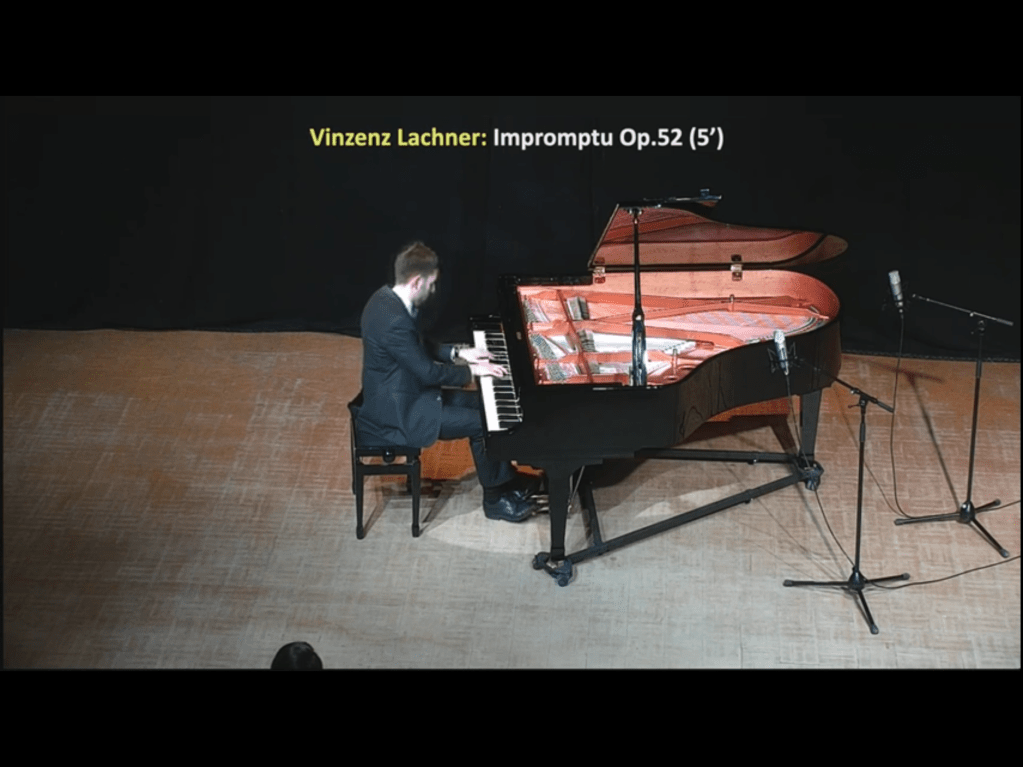
Vinzenz Lachner (also spelled Vincenz) (19 July 1811 – 22 January 1893)was a German composer and conductor.Born in Rain am Lech in Bavaria .Vinzenz was the youngest brother of Franz Lachner also a composer and conductor and a close friend of Schubert.As a composer Vinzenz was essentially self-taught and was first educated by his father Anton Lachner, the municipal organist.Like all the Lachner brothers, he was friendly with Brahms and in 1879, he wrote a letter to Brahms asking why he had used trombones, tuba, and a drumroll — trombones being associated with death — early in the pastoral first movement of his Second Symphony.Brahms replied in detail, expressing the “great and genuine” pleasure he received from the letter, calling Lachner’s analyses unusually perceptive and insightful, then saying “I would have to confess that I am, by the by, a severely melancholic person, that black wings are constantly flapping above us” Lachner died in Karlsruhe after a number of strokes at the age of 81.Lachner’s compositions include symphonies, overtures, festive marches, works for wind orchestra; a Mass in D minor, a setting of the 100th Psalm and other choral works; incidental music to Schiller’s Turandot ; a tone poem entitled Lagerleben; a Piano Quartet, String Trio, two String Quartets, 42 Variations on the C major scale, Op. 42, for piano or string quartet;Deutsche Tanzweisen for cello and piano; a set of Landler for piano duet (dedicated to Brahms); and numerous songs of which the cycle Scherz im Ernst und Ernst im Scherz was popular during his lifetime. His song-cycle Frauenliebe und legend appeared in c1839, not long before Schumann made his better-known settings of Adelbert von Chamisso’s poems.Few of his works have been revived or reprinted, though a recording of the string quartets issued in 2005 reveals a minor master of that genre.
It was interesting to hear this short salon piece by Lachner with its gloriously rich tenor melody that gave way to an exuberant jeux perlé stream of notes that was very reminiscent of Mendelssohn.It led so well to the charm and ravishing colours of the Valse Caprice by Tausig of Strauss’s ‘Nachtfalter’.It was played with the style and charm of a lost age of teasing rubati and exuberant virtuosity that all the great pianists of the past would end their recitals with.A little Mazurka by Scriabin was Damir’s way of thanking his very appreciative audience at Cranleigh Arts
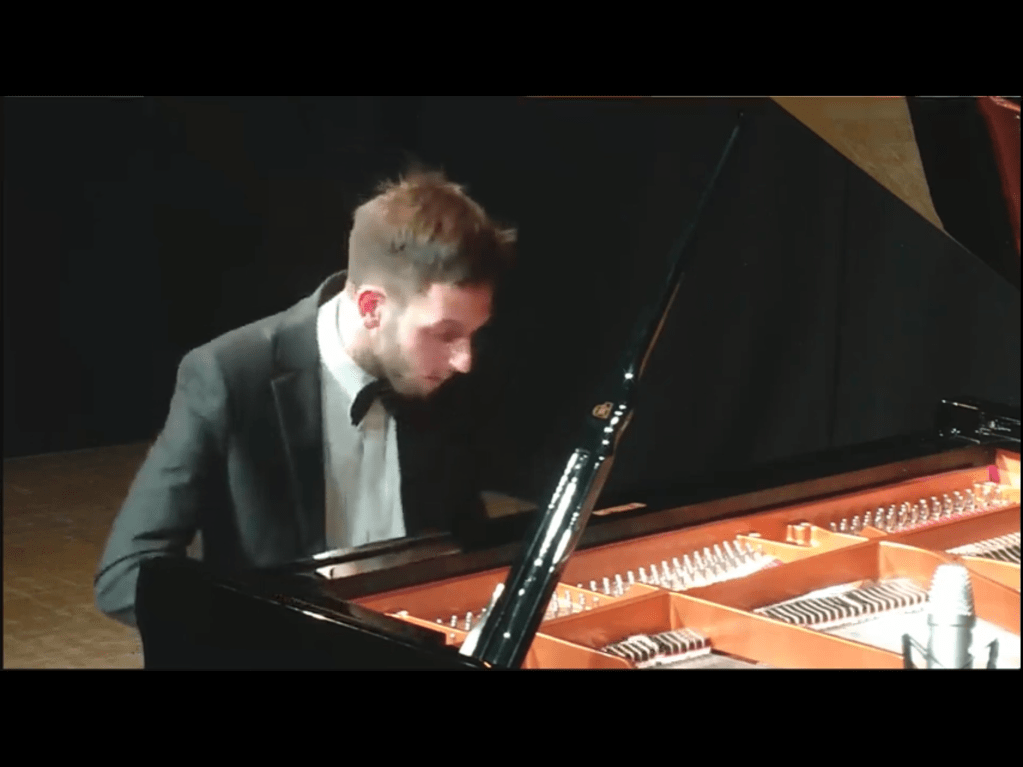
As an internationally sought-after performer, Damir Durmanovic has performed in venues and festivals including the Wigmore Hall, Champs Hill Studios, YPF Festival Amsterdam, Wimbledon Music Festival, Renia Sofia Audotorium Madrid, Gstaad Menuhin Festival, Derby Multifaith Center, Flusserei Flums, ‘Ballenlager’ Vaduz. He has won prizes in numerous international competitions including The Beethoven Intercollegiate Junior Competition in London, Adilia Alieva International Piano Competition in Geneva and Isidor Bajic International Piano Competition in Novi Sad.He has performed in masterclasses with Claudio Martinez-Mehner, Dmitri Bashkirov, Pascal Devoyon, Jacques Rouvier, Robert Levin, Jean-Bernard Pommier, Tatyana Sarkisova, and chamber ensembles such as the Emerson Quartet. Damir is also a scholar at the ‘Musikakademie Liechtestein’ and regularly participates in the courses organised by the academy.Damir began his studies at age of eight in his home country, Bosnia and Herzegovina, with Maja Azabagic before continuing his studies at the Yehudi Menuhin School where he studied with professor Marcel Baudet.Damir is an ABRSM scholar and is kindly supported by the Talent Unlimited Scheme. He has been studying at the Royal College of Music in London with professor Dmitri Alexeev where he graduated in 2021.Damir is supported by the Keyboard Trust
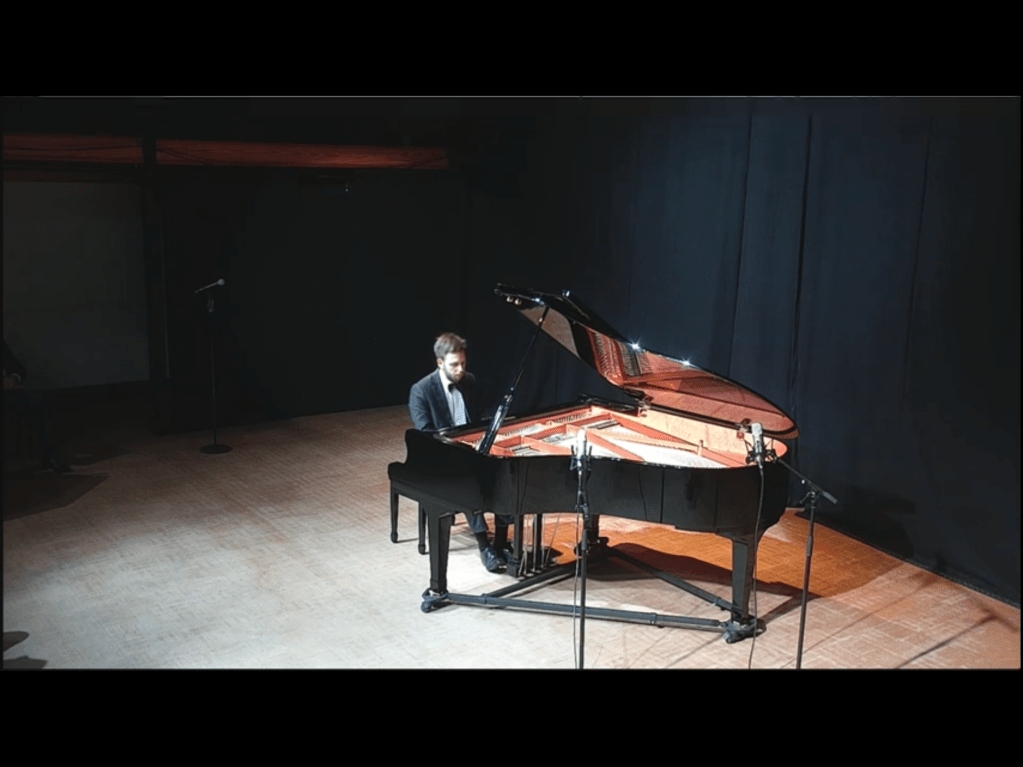
4 risposte a "Damir Duramovic at Cranleigh Arts A musician speaks with simplicity and poetry"